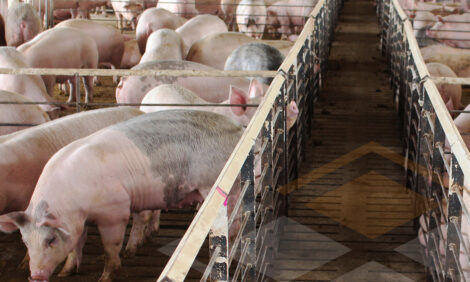



NADIS Pig Health Bulletin - Rotaviral Diarrhoea
Pig veterinarian, Mark White, explains why rotavirus has become a common causes of scours in baby piglets. With antibiotic treatment ineffective, he recommends management techniques and support therapy to control and treat the condition. The article was published in the October 2008 issue of the NADIS Pig Health Bulletin.


With the widespread use of highly effective E. coli vaccines in sows to protect the neonatal pig from scour associated with these bacteria, one of the more common causes of such disease in baby piglets is rotaviral infection. Because it is a virus, antibiotic treatments are ineffective and to date there are no vaccines available. Management techniques and support therapy thus form the basis for control and treatment of this condition.
The Cause
At least four different strains of rotavirus are known to exist with three of these capable of producing disease in the young pig. There is very little cross-immunity between the strains and it is possible for a group of piglets to be infected with, and affected by, more than one strain either simultaneously or sequentially.
The sources of the virus for the young pig are:
- The sow – up to 30% of sows excrete virus around the farrowing period
- The environment - the virus can survive in warm moist conditions for months but is reasonably vulnerable to desiccation and standard approved disinfectants.
Rotavirus can be found in virtually all pig populations and so the detection of the virus in the faeces is not a definitive diagnosis of the disease – the appropriate associated pathology in the gut needs to be demonstrated. In many instances, rotaviral disease can occur in association with other pathogens such as coccidia, E.coli (typically in pigs of 4 days plus if sows/gilts are vaccinated) and clostridia.
What does the virus do?
Rotavirus is capable of producing disease in piglets from a day-old through into the weaning phase. The virus damages the gut lining in such a way as to shrink the villi – the finger-like microscopic surface of the intestine – which then limits digestibility and absorption of nutrients. The upper small intestine – where the majority of milk digestion should occur – is particularly vulnerable and these pigs become intolerant of milk (and indeed creep feed). The passage of undigested food into the lower small intestine and large intestine has two effects:
- It provides a substrate for bacterial multiplication lower down the gut leading to secondary disease
- It can have an osmotic effect in the large intestine preventing water reabsorbtion.
The net result is a scour, which can vary in consistency from pasty, through watery with yellow/white floccules to almost pure watery liquid. It may be seen as early as 8-10 hours after birth suggesting possible initial infection prior to birth (more likely to be from ascending infection of the uterus rather than transplacental).
Mortality associated with rotaviral infection is highly variable. The younger the pig affected, the more likely death will be. Death is due to dehydration, although affected pigs may be overlaid and crushed before they die. Where secondary infection by, for example, E. coli or clostridia occurs, death can be due to toxaemia originating from these bacteria.
Diagnosis
Rotaviral scour should always be suspected as a cause of diarrhoea in young piglets both before and after weaning and should be differentiated from other causes of scour, including other viral causes such as PRRS virus and TGE/Epidemic Diarrhoea viruses.
Rotavirus can be detected in faeces of both normal and scouring piglets using the polyacrilamide gel electrophoresis (PAGE) test but to confirm rotavirus as the cause of scour it is necessary to demonstrate characteristic damage to the gut wall, in a sacrificed pig. A 1-cm section of duodenum, ileum (plus colon and caecum) should be fixed in formal saline within 10 minutes of death. Any delay leads to auto-digestion of the gut lining rendering histopathology useless. Microscopic inspection of these fixed sections of the gut will reveal typical villus atrophy in rotavirus-affected pigs. Other than the presence of liquid intestinal contents, the post mortem picture with rotavirus is unremarkable and not characteristic.
Additionally, it is possible to inspect the gut lining grossly by dripping water onto the exposed mucosa of the normal gut lining. (A hand lens will assist visibility). This will not be seen in a rotavirus-affected gut. (Such a picture is easier to see in weaned pigs than in newborns.)
Treatment
Treatment of the individual pig with rotaviral disease relies on support therapy whilst the pig itself recovers and develops its own immunity. Electrolytes – constituted to the correct dilution – are essential to provide daily requirements for amino acids (glycine) and carbohydrates (glucose) and can act as a temporary substitute for milk. Where complicating bacteria are implicated, specific antibiotic therapy – ascertained by the attending veterinary surgeon – should be given.
If older pigs are affected, creep feed should be withdrawn whilst pigs are scouring and can be gradually reintroduced once recovered.
Some producers believe yoghurt or probiotics can prove effective treatments for rotaviral scour although the evidence for this is equivocal.
Remember that a recovered pig is still vulnerable to challenge and disease by alternate strains of rotavirus if conditions allow.
Control
Since there is no specific treatment for rotavirus infection, commercial vaccines are unavailable for pigs. The cattle rotavirus vaccine is not appropriate for use in pigs, and it is not feasible to make an autogenous vaccine. Control of rotavirus relies upon a mixture of attention to hygiene and attempting to raise immunity in sows to improve both colostral and milk transfer of antibodies.
Hygiene measures rely upon the tried and tested methods of farrowing house husbandry:
- Operate room on an all-in, all-out basis
- Remove sow faeces from the pen preferably twice daily – do not rely on dispersal through slatted flooring
- Ensure food/water supply does not allow pen to become wet and dirty
- Control room temperature to avoid sows deliberately wetting and contaminating pen
- Wash out room/pen in between successive farrowings using an initial detergent (especially if only cold water power washing). Follow up with an appropriate disinfectant at the correct (“general orders”) rate and leave at least 6 hours to work. Ensure pens are fully dry before reoccupation.
Terminal cleaning can be supplemented with lime washing – a thick emulsion of hydrated lime painted onto all surfaces with which pigs have contact. However, lime burns and so care must be taken when handling the material and treated pens must be allowed to cure for four days before reoccupation.
Experience suggests that sow immunity can be improved by exposing them to infected material in the later stages of gestation. Where scour was occurring, the following approach was used in the past:
- Collection of scour from pens – if necessary by wiping up with tissues. Scoured piglets can be encouraged to defecate by gently squeezing the abdomen whilst raising the tail manually
- Dilution 50:50 with water – preferably unchlorinated
- Provision to pregnant sows twice weekly at a ‘dose’ of 5ml/sow starting at day 80 of gestation and stopping 24 hours or more prior to moving to a clean farrowing pen. It was always recognised that material should never be fed back to sows of less than 75 days gestation
Such a programme was normally highly effective and by definition self-limiting – effectiveness means no scour will be available. In small herds, the disease will often burn itself out but in larger breeding sites, it may return in waves.
A word of warning: pigs excrete a wide range of organisms in faeces and it is possible to create disease problems by exposing pregnant sows to contaminated material, e.g. erysipelas, PRRS. Where disease problems arose in sows in late pregnancy, feedback was stopped and further veterinary guidance sought.
Cost
Due to its highly variable nature, the costs of rotaviral disease can range from the negligible to the severe. Mortality rates of 5% due to rotaviral scour can occur representing a loss of piglets over a 3 month period in a 500 sow herd of 150 piglets each with a value to the breeder feeder of approximately £35 – a total of over £5000. Similarly, affected pigs can be up to 1kg light at weaning adding 10 days to slaughter weight requiring up to £3 in additional food cost. Thus in a severe outbreak lasting 3 months, financial losses can reach £14 – £15,000 in a 500-sow herd.
November 2008





